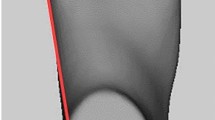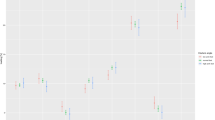Abstract
Objective:
There is debate as to the effects of obesity on the developing feet of children. We aimed to determine whether the flatter foot structure characteristic of obese primary school-aged children was due to increased medial midfoot plantar fat pad thickness (fat feet) or due to structural lowering of the longitudinal arch (flat feet).
Methods and procedures:
Participants were 75 obese children (8.3±1.1 years, 26 boys, BMI 25.2±3.6 kg m−2) and 75 age- and sex-matched non-obese children (8.3±0.9 years, BMI 15.9±1.4 kg m−2). Height, weight and foot dimensions were measured with standard instrumentation. Medial midfoot plantar fat pad thickness and internal arch height were quantified using ultrasonography.
Results:
Obese children had significantly greater medial midfoot fat pad thickness relative to the leaner children during both non-weight bearing (5.4 and 4.6 mm, respectively; P<0.001) and weight bearing (4.7 and 4.3 mm, respectively; P<0.001). The obese children also displayed a lowered medial longitudinal arch height when compared to their leaner counterparts (23.5 and 24.5 mm, respectively; P=0.006).
Conclusion:
Obese children had significantly fatter and flatter feet compared to normal weight children. The functional and clinical relevance of the increased fatness and flatness values for the obese children remains unknown.
This is a preview of subscription content, access via your institution
Access options
Subscribe to this journal
Receive 12 print issues and online access
$259.00 per year
only $21.58 per issue
Buy this article
- Purchase on Springer Link
- Instant access to full article PDF
Prices may be subject to local taxes which are calculated during checkout



Similar content being viewed by others
References
Bordin D, De Giorgi G, Mazzocco G, Rigon F . Flat and cavus foot, indexes of obesity and overweight in apopulation of primary-school children. Minerva Pediatr 2001; 53: 7–13.
Dowling AM, Steele JR, Baur LA . Does obesity influence foot structure and plantar pressure patterns in prepubescent children? Int J Obes Relat Metab Disord 2001; 25: 845–852.
Mickle KJ, Steele JR, Munro BJ . The feet of overweight and obese young children: are they flat or fat? Obes Res 2006; 14: 1949–1953.
Riddiford-Harland DL, Steele JR, Storlien LH . Does obesity influence foot structure in prepubescent children? Int J Obes Relat Metab Disord 2000; 24: 541–544.
Welton EA . The Harris and Beath footprint: interpretations and clinical value. Foot Ankle 1992; 13: 462–468.
Mauch M, Grau S, Krauss I, Maiwald C, Horstmann T . Foot morphology of normal, underweight and overweight children. Int J Obes 2008; 32: 1068–1075.
Villarroya MA, Esquivel JM, Tomas C, Moreno LA, Buenafe A, Bueno G . Assessment of the medial longitudinal arch in children and adolescents with obesity: footprints and radiographic study. Eur J Pediatr 2009; 168: 559–567.
Tax HR . Podopediatrics, 4th ed. Williams & Wilkins: Baltimore, MD, 1985.
Volpon JB . Footprint analysis during the growth period. J Pediatr Orthop 1994; 14: 83–85.
Riddiford-Harland DL, Steele JR, Baur LA . Are the feet of obese children fat or flat? 14th Annual Scientific Meeting of the Australasian Society for the Study of Obesity; 28–30 October 2005; Glenelg, South Australia.
Jones RA, Okely AD, Collins CE, Morgan PJ, Steele JR, Warren JM et al. The HIKCUPS trial: a multi-site randomized controlled trial of a combined physical activity skill-development and dietary modification program in overweight and obese children. BMC Public Health 2007; 7: 15.
Cole TJ, Bellizzi MC, Flegal KM, Dietz WH . Establishing a standard definition for child overweight and obesity worldwide: international survey. BMJ 2000; 320: 1240–1243.
Parham K, Gordon C, Bensel C . Anthropometry of the Foot and Lower Leg of U.S. Army Soldiers: Fort Jackson, S.C. Army Natick Research, Development and Engineering Center: Natick, MA, 1992.
Riddiford-Harland DL, Steele JR, Baur LA . The use of ultrasound imaging to measure midfoot plantar fat pad thickness in children. J Orthop Sports Phys Ther 2007; 37: 644–647.
Hashimoto BE, Kramer DJ, Wiitala L . Applications of musculoskeletal sonography. J Clin Ultrasound 1999; 27: 293–318.
Vincent WJ . Statistics in Kinesiology. Human Kinetics: Champaign, IL, 1995.
Timpson NJ, Sayers A, Davey-Smith G, Tobias JH . How does body fat influence bone mass in childhood? A Mendelian randomization approach. J Bone Min Res 2009; 24: 522–533.
Williams DS, McClay IS . Measurements used to characterize the foot and the medial longitudinal arch: Reliability and validity. Phys Ther 2000; 80: 864–871.
Queen RM, Mall NA, Hardaker WM, Nunley JA . Describing the medial longitudinal arch using footprint indices and a clinical grading system. Foot Ankle Int 2007; 28: 456–462.
Ozdemir H, Yilmaz E, Murat A, Karakurt L, Poyraz AK, Ogur E . Sonographic evaluation of plantar fasciitis and relation to body mass. Eur J Radiol 2005; 54: 443–447.
Saltzman CL, Nawoczenski DA, Talbot KD . Measurement of the medial longitudinal arch. Arch Phys Med Rehabil 1995; 76: 45–49.
Ferri M, Scharfenberger AV, Goplen G, Daniels TR, Pearce D . Weightbearing CT scan of severe flexible pes planus deformities. Foot Ankle Int 2008; 29: 199–204.
Acknowledgements
We thank the research teams from the Hunter Illawarra Kids Challenge Using Parent Support (HIKCUPS) project, an Australian National Health & Medical Research Council funded project (354101), for their support during participant recruitment.
Author information
Authors and Affiliations
Corresponding author
Ethics declarations
Competing interests
The authors declare no conflict of interest.
Rights and permissions
About this article
Cite this article
Riddiford-Harland, D., Steele, J. & Baur, L. Are the feet of obese children fat or flat? Revisiting the debate. Int J Obes 35, 115–120 (2011). https://doi.org/10.1038/ijo.2010.119
Received:
Revised:
Accepted:
Published:
Issue Date:
DOI: https://doi.org/10.1038/ijo.2010.119
Keywords
This article is cited by
-
Exploring flatfeet morphology in children aged 6–12 years: relationships with body mass and body height through footprints and three-dimensional measurements
European Journal of Pediatrics (2024)
-
Foot morphology as a predictor of hallux valgus development in children
Scientific Reports (2023)
-
The resting calcaneal stance position (RCSP): an old dog, with new tricks
European Journal of Pediatrics (2023)
-
Children’s foot parameters and basic anthropometry — do arch height and midfoot width change?
European Journal of Pediatrics (2022)
-
Foot loading patterns in normal weight, overweight and obese children aged 7 to 11 years
Journal of Foot and Ankle Research (2013)



